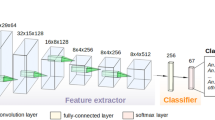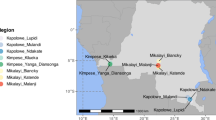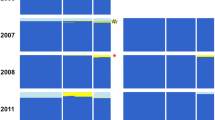Summary
The mitotic chromosomes of the sibling species A and B of the Anopheles gambiae complex were stained with Hoechst 33258 and examined by fluorescence microscopy. The autosomes fluoresce homogenously and similarly in both species while the sex chromosomes differ in the location and brightness of some heterochromatic blocks. These cytochemical differences allow the cytotaxonomic identification of these cryptic species.
Similar content being viewed by others
Article PDF
References
Coluzzi, M. 1968. Cromosomi politenici delle cellule nutrici ovariche nel complesso gambiae del genere Anopheles. Parassitologia, 10, 179–184.
Coluzzi, M, and Sabatini, A. 1967. Cytogenetic observations on species A and B of the Anopheles gambiae complex. Parassitologia, 9, 73–88.
Coluzzi, M, and Sabatini, A. 1968. Cytogenetic observations on species C of the Anopheles gambiae complex. Parassitologia, 10, 155–165.
Coluzzi, M, and Sabatini, A. 1969. Cytogenetic observations on the salt water species, Anopheles merus and Anopheles melas, of the gambiae complex. Parassitologia, 11, 177–187.
Comings, D E. 1975. Mechanisms of chromosome banding VIII. Hoechst 33258-DNA interaction. Chromosoma (Berl), 52, 229–243.
Davidson, G. 1964. The five mating types in the Anopheles gambiae complex. Riv Malariol 43, 167–183.
Davidson, G, and Hunt, R. 1973. The Crossing and chromosome characteristics of a new, sixth species in the Anopheles gambiae complex. Parassitologia, 15, 121–128.
Ellison, J R, and Barr, H J. 1971. Differences in the quinacrine staining of the chromosomes of a pair of sibling species: Drosophila melanogaster and Drosophila simulans. Chromosoma (Berl), 34, 424–435.
Gatti, M, Tanzarella, C, and Olivieri, G. 1974a. Variation with sex of irradiation induced chromosome damage in somatic cells of Drosophila melanogaster. Nature, 247, 151–152.
Gatti, M, Tanzarella, C, and Olivieri, G. 1974b. Analysis of the chromosome abberations induced by X-rays in somatic cells of Drosophila melanogaster. Genetics, 77, 701–719.
Gatti, M, Pimpinelli, S, and Santini, G. 1976. Characterization of Drosophila heterochromatin. I. Staining and decondensation with Hoechst 33258 and Quinacrine. Chromosoma (Berl), 57, 351–375.
Holmquist, G. 1975a. Hoechst 33258 fluorescent staining of Drosophila chromosomes. Chromosoma (Berl), 49, 333–356.
Holmquist, G. 1975b. Organisation and evolution of Drosophila virilis heterochromatin. Nature, 257, 503–506.
Latt, S A, and Wohlleb, J C. 1975. Optical studies of the interaction of 33258 Hoechst with DNA, chromatin, and metaphase chromosomes. Chromosoma (Berl), 52, 297–316.
Pimpinelli, S, Santini, G, and Gatti, M. 1976. Characterization of Drosophila heterochromatin. II. C-and N-banding. Chromosoma (Berl), 57, 377–386.
Pimpinelli, S, Gatti, M, and De Marco, A. 1975. Evidence for heterogeneity in heterochromatin of Drosophila melanogaster. Nature, 256, 335–337.
Weisblum, B, and Haenssler, E. 1974. Fluorometric properties of the bibenzimidazol derivative Hoechst 33258, a fluorescent probe specific for AT concentration in chromosomal DNA. Chromosoma (Berl), 46, 255–260.
White, G B. 1974. Anopheles gambiae complex and disease transmission in Africa. Trans R Soc Trop Med Hyg, 68, 278–301.
Author information
Authors and Affiliations
Rights and permissions
About this article
Cite this article
Gatti, M., Santini, G., Pimpinelli, S. et al. Fluorescence banding techniques in the identification of sibling species of the Anopheles gambiae complex. Heredity 38, 105–108 (1977). https://doi.org/10.1038/hdy.1977.11
Received:
Issue date:
DOI: https://doi.org/10.1038/hdy.1977.11
This article is cited by
-
Genetics of mosquitoes
Journal of Genetics (1999)
-
Giemsa C-banding in four species of mosquitoes
Chromosoma (1982)
-
Satellite DNA of Anopheles stephensi liston (Diptera: Culicidae)
Chromosoma (1981)
-
Intraspecific polymorphism of sex chromosome heterochromatin in two species of the Anopheles gambiae complex
Chromosoma (1980)



